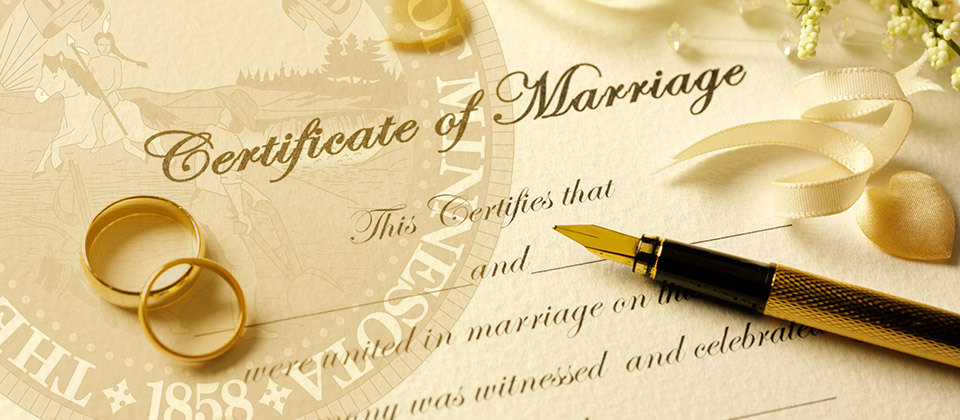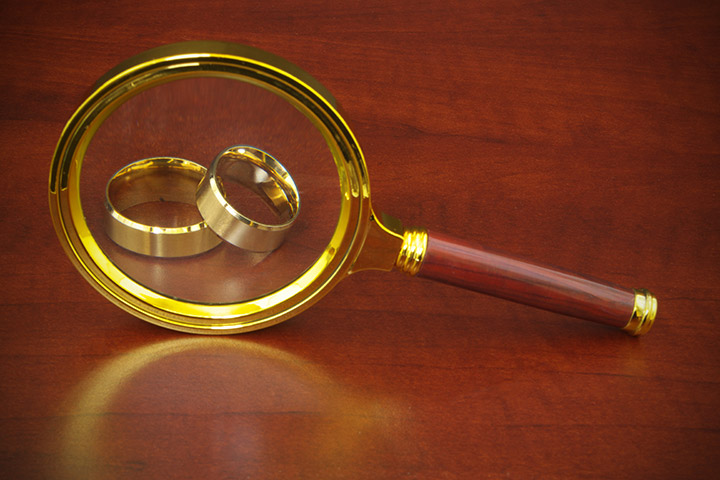Guide to Minnesota Marriage Records

Minnesota marriage records are simple documents, guaranteed by the district court, that confirm the legitimacy of your union. It may be tedious to prove your marriage to a government or company, but it's a necessary step to take advantage of the many benefits that marriage provides.
However, some people struggle to request something from a government website or office. They're not known for being particularly efficient or easy to navigate. The best option is to use a single resource to get your marriage records to you in the shortest time possible.
What Are Minnesota Marriage Records and How Are They Stored?
Minnesota marriage records are government documents that prove your marriage is legitimate. They're primarily used in name change procedures, genealogical research, decorative purposes, and some divorce court processes.
These documents don't contain particularly dangerous information, containing only the bare minimum to serve their purpose. The courts don't require your email address and social security number to confirm that you were wed to John Blake on November 18th.

Typically, details of Minnesota marriage records include:
- First and last names of spouses
- Names and signatures of witnesses
- Date of the Ceremony
- The county that issued the license
Some counties ask for personal identifiers, like date of birth, but those cases are rare. That type of information is usually restricted to the application you send in to receive the marriage license in the first place.
Unlike other states, Minnesota marriage records cannot be found in the state's Office of Vital Records. This is true for both certified and unofficial copies. These records are the sole responsibility of individual counties. However, the county information is collected into a searchable, centralized database managed by The Minnesota Association of County Officers (MACO).
Marriage License
Attempting to search out your marriage license on your own will probably lead you to applications for a marriage license. This is NOT the same as a marriage record.
Licenses are documents given to the spouses prior to a wedding. It awards the couple the right to be wed in a county and must be signed by witnesses and the overseeing officiant. Only after this license is signed and returned to the district court is it officially designated as a marriage record.
So, ensure the page you're looking at is for post-marriage records. Otherwise, you're wasting your time hunting down the wrong papers.
Minnesota Marriage Statistics

Marriage statistics are essential for both governmental and individual decision-making. Factors like when people get married and how long they stay married help inform decisions on how Federal programs are shaped. In some ways, the success of a state's marriages represents society's overall health.
Couples considering marriage can also look at the numbers and decide if they're ready for the big plunge. Looking at the success metrics of people of a similar age and socioeconomic status can put things in an objective light.
Some of the most relevant marriage statistics for Minnesota include:
- Marriage Rates: The Minnesota married population has dropped drastically in the past thirty years. In 1990, there were 7.7 marriages per 1000 people, which is comparable to the national average. Today, that number has fallen to 4.8, roughly a 40 percent decline. Demographers believe this is due to the aging population and the lack of job opportunities for younger men.
- Average Marrying Age: In 2015, trends showed climbing ages for Minnesota marriages, but the stat has since fallen in line with national averages. U.S. marrying ages are 26.5 for women and 28.7 for men. Minnesota matches this nearly exactly with ages of 26.6 for women and 28.5 for men.
- Average Duration Before Divorce: Minnesota is one of 5 states that doesn't report divorce data to the National Center for Health Statistics. However, following inter-state trends, midwestern and eastern marriages tend to last longer than in western states. For example, South Dakota has a median marriage duration of 21.8 years, while Washington D.C.'s is a mere 10.5 years.
- Divorce Rates: According to independent surveys by the World Population Review, Minnesota boasts an extremely low divorce rate of 10.2 percent. This is a paltry sum compared to the national average of 35 to 50 percent.
How to Find Minnesota Marriage Records

You have multiple options for finding Minnesota marriage records. The MACO manages an online portal called the Minnesota Official Marriage System (MOMS), which holds records from most of the state's counties.
Of course, requestors may still visit district clerks' offices and courts in person. People who require their marriage records right away should opt for this method.
It would help if you had the following information ready to make the process quick and painless.
- The county that issued the marriage license
- Spouses' names before marriage
- Ceremony date including month, day, and year
While you can still find a record without some of this information, having it prevents delays and additional search fees. We'll go over the exact steps for requesting marriage records offline and online.
Online
Minnesota marriage records are available online through the coincidentally named portal MOMS. However, it isn't a true online process. There is no option for online payment, and requestors must still send physical mail to the county office, including their payment method.
All you have to do is:
- Go to moms.mn.gov
- Click on the "Certificate Search" section in the taskbar
- Select "All Participating Counties" in the County field
- Input one of the spouse's full name
- Provide a range of dates the ceremony took place
- Mail a money order or credit card information to the county's vital records department
Remember that this is a centralized database, but it's not guaranteed that your desired marriage records have been transferred. MOMS is frequently updated, but there is no standard time before new marriages are added. If your wedding was more recent, in-person is still the most reliable choice.
Offline
Anyone requiring an immediate certified marriage record must visit the court that distributed the couple's license. This rule applies even if you weren't married in that exact county.
Every county has a different form to apply with, but they're all called something like the "Marriage Certificate Request Form". These forms are only half a page long and can be filled out on-site, so ensure you have the correct information ready.
You can call your local district court's office if you don't know what county originally recorded the marriage record. Although they cannot provide you with a certified copy, they can point you in the right direction.
Another option is to order the marriage certificate by mail or fax. Send the appropriate form along with the required fee. You can expect to pay less than $10, but an office representative should confirm the exact amount.
If you can't find the appropriate form, most counties accept informal requests so long as all the relevant information is included. You can draft an informal request application by following this form's layout.
What Is NOT Included in Marriage Records and Potential Errors and Omissions
Marriage records have only one purpose: to prove the legitimacy of a marriage. Only the minimum amount of information required for that task is included. Between the spouses, officiant, and witnesses, the whole document is basically a contact list of people who can confirm the event took place.
Risky information like social security numbers aren't needed. The couple's identities are proven when applying for the marriage license, and the future record is publicly available in Minnesota, so it'd be too dangerous to include details of that nature.
Would-be brides and grooms should be more concerned about the risks of typos and other errors. While there aren't concrete penalties for incorrectly filling out a marriage record, it will make it harder to track down in the future. For example, if you misspell John Hancock, you can't find it using the correct spelling since it won't appear in search results.
District Court Directory
Now that you know how to locate a marriage record, you still need to know who to call. Many offices welcome walk-ins, but it's often more comfortable to contact the office beforehand to set up an appointment or confirm the record's existence.
We've compiled a list of the top ten most populous Minnesota counties alongside the contact information for the district recorders or the court offices.
| County | Phone Number |
|---|---|
| Hennepin County | (612) 348-8240 |
| Ramsey County | (651) 266-1333 |
| Dakota County | (651) 438-4312 |
| Anoka County | (763) 323-5400 |
| Washington County | (651) 430-6175 |
| St. Louis County | (218) 726-2559 |
| Olmsted County | (1-888) 280-7708 |
| Stearns County | (916) 874-6334 |
| Scott County | (925) 335-7900 |
| Wright County | (559) 600-5956 |
FAQ on Marriage Records in Minnesota
How long will it take to get a copy of my marriage record in Minnesota?
If you reside in the same county that processed your marriage license, you can visit the district court and get your marriage record in a day.
MOMS has an option for 'Expedited Processing' for an additional $20. However, this only speeds up how quickly the office takes to find your marriage records internally. You'll still have to wait 7 to 14 business days for the documents to ship through U.S. Mail.
Who can request marriage records in Minnesota?
Minnesota marriage records are publicly available. Unlike other states that require requestors to prove a connection to the named spouses, in Minnesota, anyone can order marriage records for a small fee.
No notarized letter of permission or proof of representation is required in MOMS' request process, but this may change when visiting the county's vital records office in person.
Can I request an online or digital copy of a marriage record?
Unfortunately, you can't. Although MOMS is an online portal, it sends marriage records through physical mail, not email. While this dramatically increases the wait time, it also means that all certified records will include a raised seal proving the document's authenticity.
How much does a marriage record cost?
The cost of a certified marriage record varies between counties, but not by much. Offices charge either $9 or $10 for in-person visits; you don't have to worry about additional fees.
MOMS also doesn't charge shipping fees, as they're seemingly baked into the standard $9 cost. However, a 2.39 percent service fee is charged by Visa, MasterCard, and Discover credit cards. MOMS also only accepts Visa brand debit cards, which are subject to a $3.95 per transaction service fee.
MOMS also doesn't charge shipping fees, as they're seemingly baked into the standard $9 cost. However, a 2.39 percent service fee is charged by Visa, MasterCard, and Discover credit cards. MOMS also only accepts Visa debit cards, which are subject to a $3.95 per transaction service fee.
